How AI & Blockchain Are Supercharging DAOs
What if DAOs could be smarter and more secure? With the integration of AI and Blockchain, they can be! Here’s how the AI and Blockchain integration is taking decision-making, security, transparency, and governance to the next level:
1. Smarter Decisions with AI
AI helps DAOs analyze data and predict outcomes, making decisions faster and more accurately. Blockchain ensures these decisions are secure and transparent, with every action recorded immutably.
2. Ironclad Security
Blockchain keeps everything safe by securely verifying transactions. AI steps in to detect threats and prevent any malicious actions, making your DAO even more protected.
3. Full Transparency
Blockchain makes every decision visible and trackable, while AI gives real-time updates, helping members stay informed and ensuring full accountability.
4. Fair, Automated Governance
Smart contracts automatically execute decisions based on clear rules, ensuring fairness. AI helps automate tasks and gathers feedback to keep governance smooth and efficient.
AI and Blockchain together make DAOs more efficient, secure, and transparent. Blockchain powers trust and security, while AI adds intelligence and automation. This combo helps DAOs adapt to the community’s needs and run at their best. the community and operate with greater effectiveness.
How AI in DAOs is Transforming Governance, where we explore how these technologies are reshaping decision-making and operational efficiency.
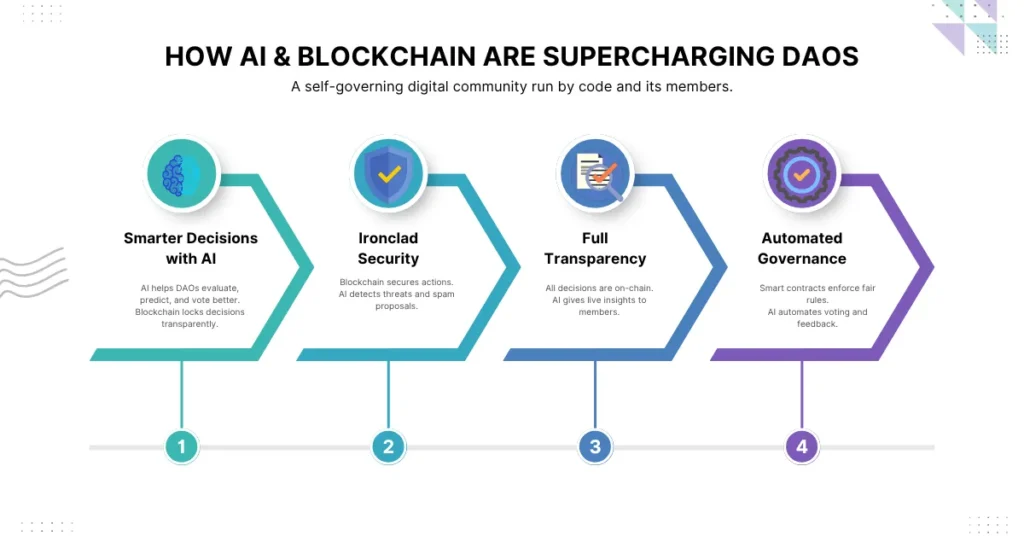
Understanding the Core Concepts
What is Artificial Intelligence (AI)?
Artificial Intelligence (AI) refers to the simulation of human intelligence in machines programmed to think, learn, and solve problems like humans. AI systems can analyze data, recognize patterns, and make decisions based on that data without explicit programming.
AI is categorized into two main types:
- Narrow AI (Weak AI): Designed to perform a specific task (e.g., voice assistants, recommendation algorithms).
- General AI (Strong AI): Aims to perform any cognitive task that a human can do (still theoretical).
AI uses technologies like machine learning (ML) and neural networks to improve over time. As it processes more data, AI can become more accurate and efficient in decision-making.
Applications of AI span various industries, including healthcare (diagnostics), finance (fraud detection), and entertainment (personalized recommendations). It’s transforming how businesses operate by increasing efficiency, accuracy, and speed.
For more on how AI is transforming decision-making processes in DAOs, check out our article on How AI Can Enhance Decision-Making in DAOs.
What is Blockchain Technology?
Blockchain technology is a decentralized digital ledger that securely records transactions across multiple computers. It ensures that data cannot be altered without altering all subsequent blocks, providing transparency and security.
The blockchain is made up of “blocks” of data, each containing a list of transactions. These blocks are linked (or “chained”) together in a chronological order, forming an unchangeable record.
Blockchain operates without a central authority. Instead, it relies on cryptographic principles and a distributed network of nodes to validate and confirm transactions, making it resistant to tampering or fraud.
Blockchain technology is the backbone of cryptocurrencies like Bitcoin and Ethereum, but its applications extend to areas like supply chain tracking, voting systems, and secure data sharing.
If you’re interested in understanding different governance frameworks, be sure to read Exploring Governance Models in DAOs
AI vs. Blockchain: How Do They Work Together in DAOs? 🔄
Artificial Intelligence (AI) and Blockchain are two powerful technologies that, when combined, can transform Decentralized Autonomous Organizations (DAOs). They complement each other by solving different challenges in governance and decision-making within DAOs.
AI enables DAOs to make data-driven decisions, analyze large datasets, predict outcomes, and automate processes. It helps DAOs run smarter by identifying patterns, optimizing voting systems, and providing real-time insights from community feedback.
On the other hand, Blockchain ensures that all transactions, votes, and decisions are secure, transparent, and tamper-proof. It guarantees trust by making all actions immutable and verifiable, allowing DAOs to function without a central authority.
Together, AI and Blockchain in DAOs create an autonomous, transparent, and secure ecosystem. AI handles dynamic decision-making, while Blockchain ensures accountability and trust. This synergy allows DAOs to operate efficiently, scale, and adapt to changing needs while maintaining decentralized governance.
Challenges & Opportunities in Implementing DAOs
DAOs have challenges like scalability, legal issues, and adoption barriers, but they also bring great opportunities for decentralized decision-making, automation, and global teamwork.
Challenges:
Security Risks:
Although blockchain is secure, DAOs can still be attacked or have flaws in their smart contracts, which could lead to losses or failures.
Scalability Issues:
As DAOs grow, managing large votes and decisions becomes harder. Blockchain limits and handling big data in real-time can slow things down.
Lack of Legal Framework:
DAOs don’t have clear regulations, which creates confusion and uncertainty, especially about responsibility and accountability.
Low Adoption:
Many people don’t fully understand DAOs yet, so they resist using them. Education about decentralized governance is needed.
Opportunities:
- Decentralized Governance:
DAOs give the community control over decisions, making the system more transparent, trustworthy, and inclusive. - Automation and Efficiency:
AI and smart contracts help DAOs run automatically, cutting out middlemen and improving efficiency. - Global Participation:
DAOs are open to anyone with internet access, creating a diverse, worldwide community. - Tokenization and Incentives:
DAOs use tokens to reward participation, giving people voting power and a stake in the network.
The Role of Web 3.0: The Future of Decentralized Digital Governance
Web 3.0 isn’t just a buzzword—it’s the game-changer that’s reshaping how the internet works. Decentralization, user empowerment, and data privacy are at its core. Unlike Web 2.0, where centralized entities control user data, Web 3.0 gives power back to individuals. Through decentralized networks, data is distributed rather than owned by any single entity.
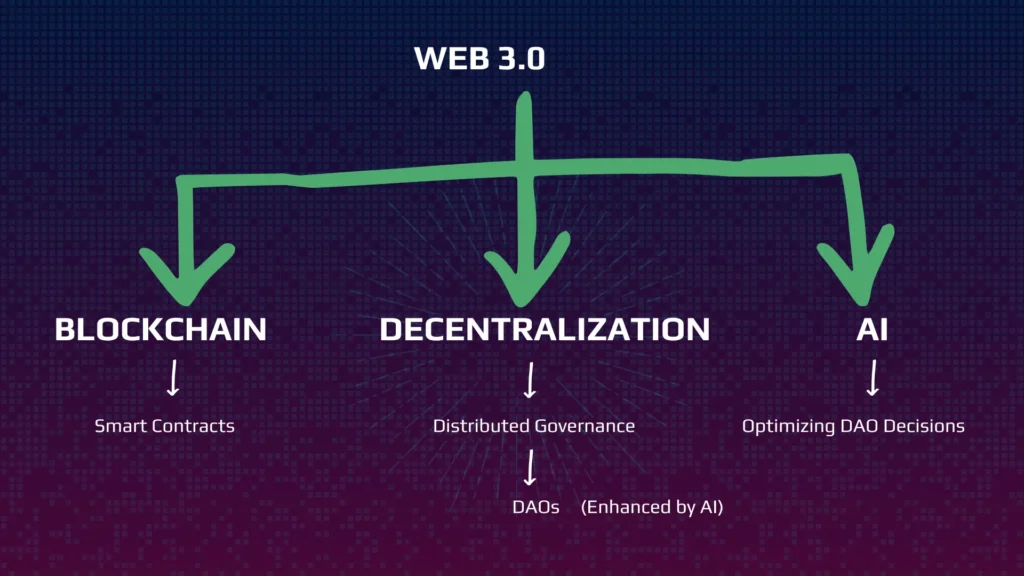
How Web 3.0 Enables DAOs
Web 3.0 is the next version of the internet, where users control their own data, identities, and digital assets. Unlike Web 2.0, which is controlled by big companies, Web 3.0 uses blockchain and decentralized networks to make the web more open, transparent, and user-controlled.
Decentralized Governance: Web 3.0 allows DAOs to operate without a central authority. Decisions are made by the community through consensus and voting.
Transparency and Security: Blockchain ensures all actions and decisions are recorded in a transparent, immutable ledger, providing trust without intermediaries.
Autonomy: Web 3.0’s decentralized networks allow DAOs to run autonomously, with smart contracts executing decisions automatically once conditions are met.
Tokenization and Rewards: Web 3.0 enables DAOs to issue tokens that represent voting power, ownership, or rewards, incentivizing participation.
Web 3.0 lets DAOs work with decentralized apps (dApps), creating an interconnected system where users can govern, collaborate, and access services without middlemen. By adding AI, Web 3.0 will make DAOs smarter, automating tasks, analyzing data, and offering real-time insights to make decisions faster and more efficiently.
The Future of DAOs in Web 3.0 with AI
AI and Web 3.0 will take DAOs to the next level by:
Boosting Engagement: AI will analyze community sentiment and suggest ways to increase participation.
Data-Driven Decisions: AI will analyze data to help DAOs make better decisions and adapt to changes.
Automated Governance: AI will handle routine tasks like vote counting and proposal analysis, making DAOs more efficient.
Predictive Capabilities: AI will predict outcomes of decisions, helping members make smarter choices.
Enhanced Security: AI will help detect fraud or threats, keeping DAOs secure.
If you’re interested in learning How to Join a DAO? and how AI and blockchain integration might impact the way people interact with DAOs, check out our detailed guide.
To further explore the future of Web 3.0, blockchain, and AI, read “The Future of Web3: How Sigma Capital’s $100M Fund is Shaping the Middle East Web3 Fund and Blockchain Innovation” to understand the global impact of Web 3.0 and its potential to revolutionize industries.
How AI and Blockchain Work Together
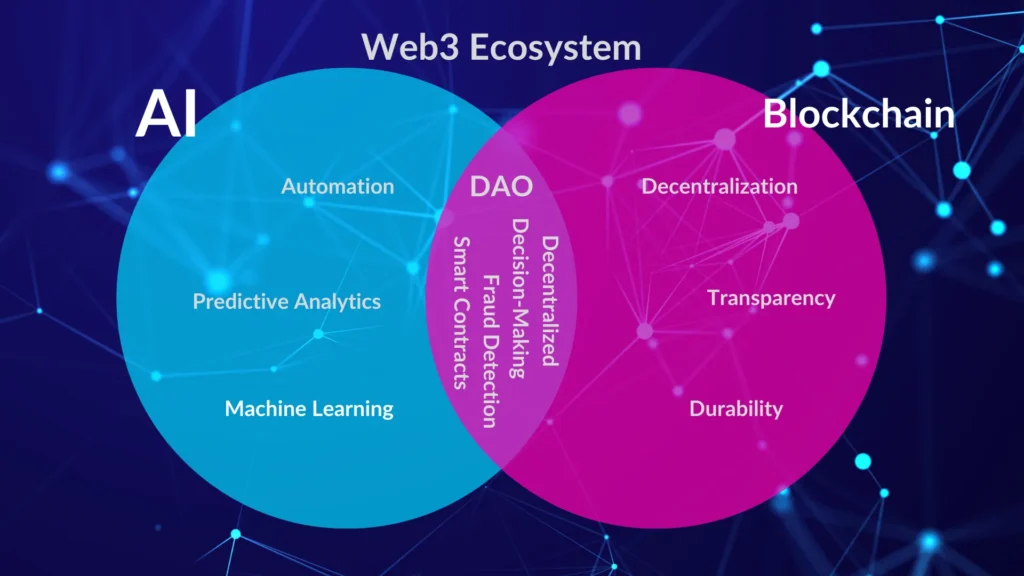
AI (Logic & Learning) + Blockchain (Trust & Transparency) = Smarter, Safer DAOs
- AI helps DAOs think — it analyzes data, learns from patterns, and suggests smart decisions.
- Blockchain makes sure everything is secure, transparent, and unchangeable — so no one can cheat or manipulate the system.
- When you combine both, you get DAOs that can make better decisions on their own while staying fair, safe, and trustworthy.
Think of it like this:
AI is the brain 🧠, and Blockchain is the memory + rules 🔐.
Together, they help DAOs run smarter and more securely.
How AI and Blockchain Are Working Together in the Real World
The combination of AI and blockchain is already changing the game across multiple industries. Together, they make systems smarter, more secure, and more efficient. Here are some real-world examples of how this powerful duo is being used:
AI-Enabled Blockchain Platforms
- Ocean Protocol
Lets people share and use data securely. Blockchain keeps it safe, and AI helps analyze it for better decision-making. - SingularityNET
A marketplace for AI services. Developers can build and sell AI tools. Blockchain ensures everything is transparent and trustworthy.
DAOs Using AI for Smarter Decisions
- Aragon
Uses AI to help DAOs analyze data and make better governance decisions. - DAOstack
AI studies voting patterns to predict outcomes and help DAOs choose the best path forward. - MolochDAO
Focuses on funding Ethereum projects. AI helps review and prioritize proposals for efficient funding.
Financial Services
- Endor Protocol
Combines blockchain and AI to predict market trends and customer behavior, using secure and accurate data.
Healthcare & Supply Chain
VeChain
Tracks products in supply chains using blockchain, while AI improves logistics and efficiency.
Solve.Care
AI analyzes patient data while blockchain keeps it safe. This helps doctors make better decisions.
AI in Decentralized Autonomous Organizations (DAOs)
AI plays a crucial role in enhancing the efficiency, decision-making, and operations of DAOs. Here’s how AI benefits DAOs:
- Smart Decision-Making: AI analyzes data from the community, helping DAOs make informed, data-driven decisions quickly.
- Automating Processes: AI can automate tasks like vote counting, proposal evaluations, and governance activities, reducing the burden on human members.
- Predicting Outcomes: AI uses historical data to predict the outcomes of proposals or governance actions, making decision-making more accurate.
- Improved Security: AI can detect fraud, suspicious activity, or anomalies, enhancing the security of DAOs by working with blockchain technology.
- Enhancing Community Engagement: AI analyzes community sentiment and provides insights on how to boost participation and engagement within DAOs.
By integrating AI, DAOs can become smarter, more efficient, and better equipped to handle complex decentralized governance.
Integration Challenges: AI & Blockchain in DAOs – and How to Overcome Them
As DAOs start using AI and blockchain, they face technical challenges like slow scalability, poor system compatibility, high costs, and heavy energy use. Solving these problems is key to helping AI-powered DAOs grow and run efficiently in the long term.
The following infographic highlights the key challenges in integrating AI and blockchain and the innovative solutions addressing them.
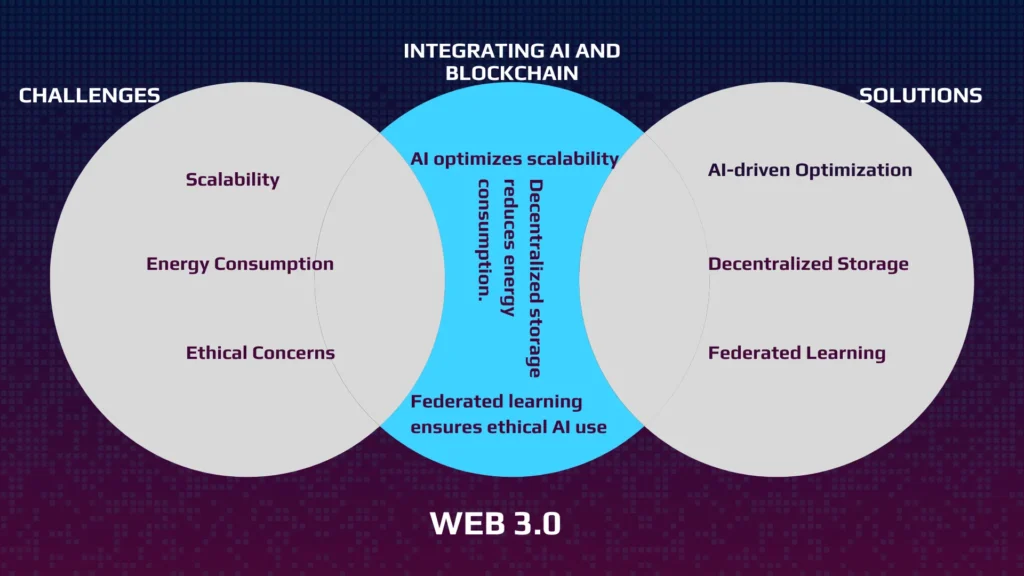
1. Technical Challenges
Challenge: Data Accessibility
Solution: Use decentralized storage solutions like IPFS or Filecoin, and connect AI via oracles for secure off-chain data access.
Challenge: On-Chain vs. Off-Chain AI
Solution: Run AI computations off-chain and relay results through blockchain oracles. Store only essential proofs or actions on-chain.
Challenge: Smart Contract Limitations
Solution: Use modular smart contracts with AI-triggered events. Include DAO-approved safety checks or validators for complex decisions.
Challenge: Latency & Scalability
Solution: Adopt Layer 2 solutions like Optimism or Arbitrum, and optimize smart contracts for speed and lower gas fees.
2. Regulatory and Ethical Challenges
Challenge: Data Privacy vs. Transparency
Solution: Implement zero-knowledge proofs or encrypted AI models to preserve privacy while keeping blockchain trust intact.
Challenge: AI Bias & Accountability
Solution: Use explainable and auditable AI models. Require transparency reports and community oversight in critical DAO decisions.
Challenge: Lack of Clear Regulations
Solution: Align with global standards (GDPR, ISO). Use flexible DAO policies that can adapt as regulations evolve.
Challenge: Explainability
Solution: Incorporate Explainable AI (XAI) tools and publish simplified summaries of how AI-based decisions were made.
3. Adoption Barriers
Challenge: Technical Literacy
Solution: Provide user-friendly dashboards, AI explainers, and community training. Focus on no-code tools where possible.
Challenge: Cost & Infrastructure
Solution: Use gas-efficient smart contracts and AI platforms like SingularityNET to reduce infrastructure costs.
Challenge: Resistance to Automation
Solution: Allow communities to control AI levels with opt-in features, voting overrides, and phased automation.
Challenge: Interoperability Issues
Solution: Use EVM-compatible tools and cross-chain integrations to ensure AI can interact across multiple blockchains.
Future Trends & Possibilities for AI-Driven DAOs
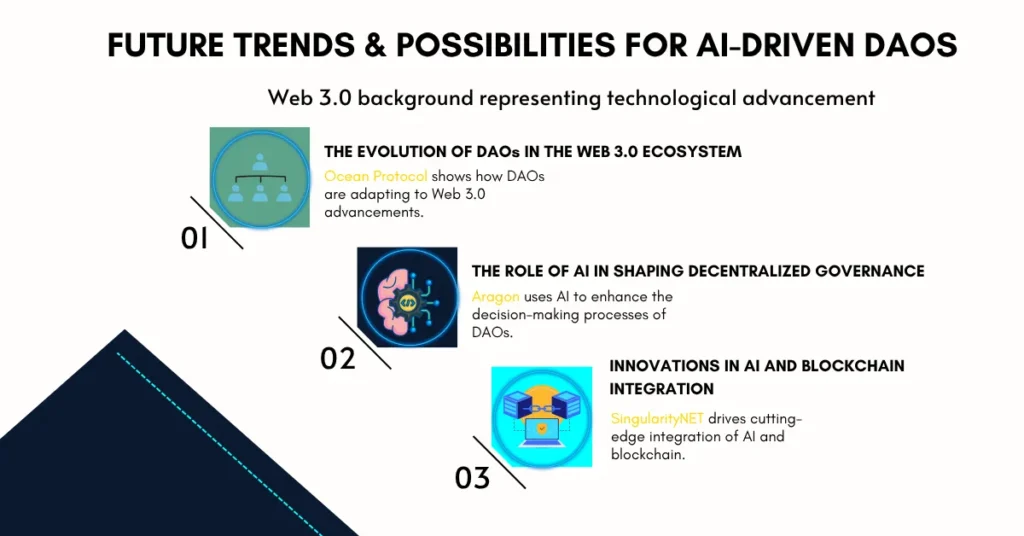
The Evolution of DAOs in the Web 3.0 Ecosystem
Decentralized Autonomous Organizations (DAOs) have evolved from basic token voting to advanced, community-governed structures. In Web 3.0, DAOs are becoming the foundation for decentralized decision-making.
Key milestones:
- Token-based governance → modular, role-based governance
- Treasury and proposal automation
- Use in DeFi, NFTs, funding, and beyond
Real-World Example:
MakerDAO – One of the first successful DAOs in DeFi, governing the DAI stablecoin. It evolved from basic governance to complex risk management and treasury operations, with millions in assets under DAO control.
The Role of AI in Shaping Decentralized Governance
AI enables DAOs to become more data-driven, scalable, and efficient by handling complex decisions and learning from behavior patterns.
AI powers DAOs to:
- Analyze voting trends
- Predict outcomes
- Automate proposal sorting, filtering, and execution
- Reduce admin load through AI bots
Real-World Example:
DAOstack – Uses AI to optimize governance by analyzing member voting behavior and adjusting incentive structures to keep engagement high.
Innovations in AI and Blockchain Integration
Combining AI and blockchain creates powerful decentralized systems that are trustless and intelligent.
Recent Innovations:
- AI bots generating DAO proposals
- Blockchain verifying AI decisions immutably
- On-chain AI triggers for real-time actions
- Privacy-preserving AI on public ledgers
Real-World Example:
Ocean Protocol – Uses blockchain to securely share data and AI to analyze it. This enables DAOs and decentralized apps to access verified, trustworthy data for training AI models — a major leap for data marketplaces in Web3.
Building DAOs with AI and Blockchain
Building a Decentralized Autonomous Organization (DAO) with AI and Blockchain requires integrating the strengths of both technologies to create a secure, transparent, and efficient decentralized system. Here’s how to build DAOs with AI and Blockchain:
Step-by-Step Guide to Building AI-Driven DAOs
The following infographic provides a concise overview of the steps involved in building an AI-driven DAO using blockchain technology.
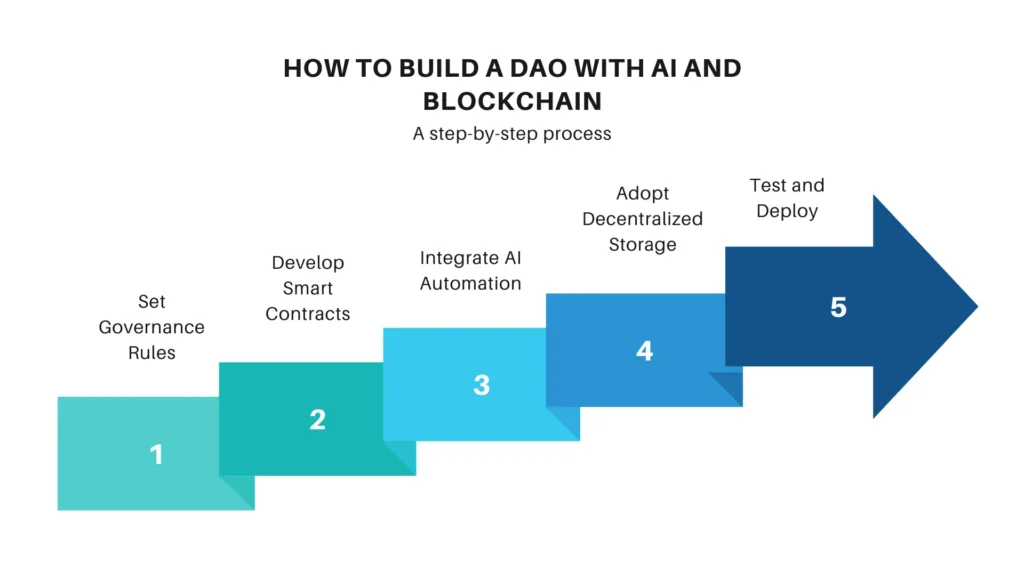
Building a successful Decentralized Autonomous Organization (DAO) that integrates AI and blockchain requires careful planning, design, and execution. In this step-by-step guide, we will walk through the essential phases of developing a DAO that leverages AI for governance, smart contracts, and decentralized storage. By following these steps, you can create a robust, efficient, and scalable DAO that aligns with the principles of decentralization and automation.
1. Designing DAO Governance Models
The first step in building an AI-powered DAO is designing the governance model. This defines how decisions are made, who votes, and how proposals are handled. AI can help make decisions more dynamic and data-driven.
Define roles and responsibilities, such as giving voting power based on contributions or stakes. AI can analyze past voting patterns and community feedback to improve governance efficiency and fairness.
Set the rules for proposal submissions. AI can evaluate proposals using historical data and predict their success. It can also automate decision-making by processing large amounts of data, reducing human involvement.
2. Developing Smart Contracts with AI Capabilities
After setting up the governance model, the next step is developing smart contracts to automate the DAO’s operations. These contracts automatically execute terms written in code, handling voting, transactions, and other processes.
To add AI, create smart contracts that adapt using real-time data and AI predictions. For example, contracts can automatically execute transactions when conditions, like a certain vote threshold, are met.
AI also boosts security by detecting potential issues in the smart contract code before deployment, ensuring it works safely and as intended.
3. Integrate AI Automation
AI enhances DAO governance by automating tasks such as sorting proposals, predicting outcomes based on past data, and analyzing community sentiment. AI can also streamline voting processes, analyze voting patterns, and recommend actions to make the DAO more efficient and responsive to change.
4. Adopt Decentralized Storage
Use decentralized storage solutions like IPFS (InterPlanetary File System) or blockchain storage to store data in a way that is secure, transparent, and accessible to all members. This reduces the reliance on centralized servers and ensures the integrity and permanence of data related to DAO operations.
5. Test and Deploy
Before fully launching the DAO, conduct thorough testing to ensure that all smart contracts and AI integrations are functioning properly and securely. This includes identifying potential vulnerabilities, ensuring proper data storage, and confirming that automated processes work as expected. Once testing is complete, deploy the DAO on the blockchain, opening it up to the community for governance.
By following these three steps—designing governance models, developing AI-powered smart contracts, and integrating decentralized storage and data analysis—you can create a highly functional, autonomous DAO. This approach not only enhances the efficiency of the DAO’s operations but also leverages the power of AI to improve decision-making, security, and adaptability. As the Web 3.0 ecosystem continues to evolve, AI-driven DAOs will play an increasingly important role in shaping the future of decentralized governance.
How to Create a DAO and Mint NFTs on Polygon: A Step-by-Step Guide for Real-World Assets
What This Means for Builders, Investors, and Users
Opportunities and Challenges for Developers in Building DAO Solutions
The rise of Decentralized Autonomous Organizations (DAOs) offers developers a chance to create innovative solutions for governance, decision-making, and automation in Web 3.0. However, building DAOs comes with challenges like coding, integration, and scalability. Here’s an overview of the opportunities and challenges developers face.
Opportunities:
- Innovation and Customization:
Developers have the chance to innovate and create custom DAO solutions that automate governance, voting, and proposal systems using blockchain and AI. - Global Reach:
DAOs operate in a borderless environment, allowing developers to reach a global community and build solutions that scale across the world. - Automation and Efficiency:
Developers can automate routine tasks (like voting and transaction management), creating more efficient systems that reduce manual effort and human errors. - Tokenization and Rewards:
With DAOs, developers can integrate tokenomics to incentivize participation and engagement, creating dynamic reward systems.
Challenges:
- Complex Governance Models:
Designing governance systems that are both fair and efficient is challenging, especially when trying to balance decentralization with automation. - Scalability Issues:
Ensuring DAOs can scale while maintaining fast transaction speeds and low costs is tough, as blockchain networks can face congestion with increased participation. - Security Risks:
Smart contract vulnerabilities are a common issue. Developers must rigorously test and audit contracts to prevent bugs and security risks that can lead to loss of funds or governance failure. - User Adoption:
DAOs often face challenges with user education and adoption. Making DAOs user-friendly and accessible to non-technical members is a key hurdle for developers.
Shaping the Future: The Power of AI, Blockchain, and DAOs
DAOs, powered by AI and blockchain, are changing how decisions are made and how organizations are run. AI helps automate processes and analyze data, while blockchain ensures transparency and security, creating a decentralized system that operates without central control.
The combination of AI and blockchain in DAOs makes governance smarter, more efficient, and data-driven, allowing decisions to be made quickly and accurately. Web 3.0, with its decentralized and user-controlled approach, provides the perfect foundation for DAOs to thrive. As technology evolves, DAOs will continue to shape a more inclusive, efficient, and transparent digital world.
TWeb 3.0 is just beginning, and now is the time to innovate. Whether you’re a developer, entrepreneur, or enthusiast, embracing AI, blockchain, and DAOs will help shape the future of decentralized systems. Dive in and be part of the transformation that will define the next generation of the internet.
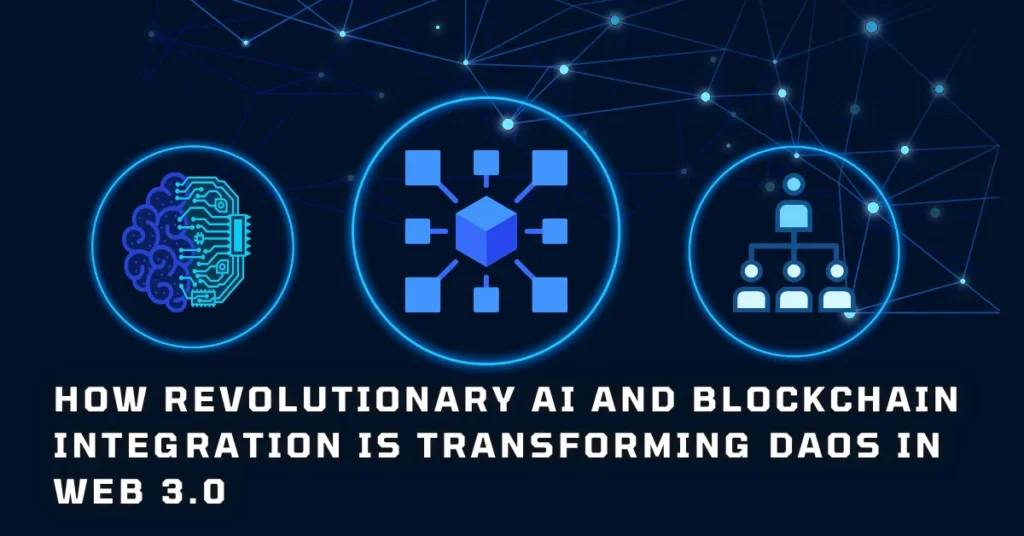
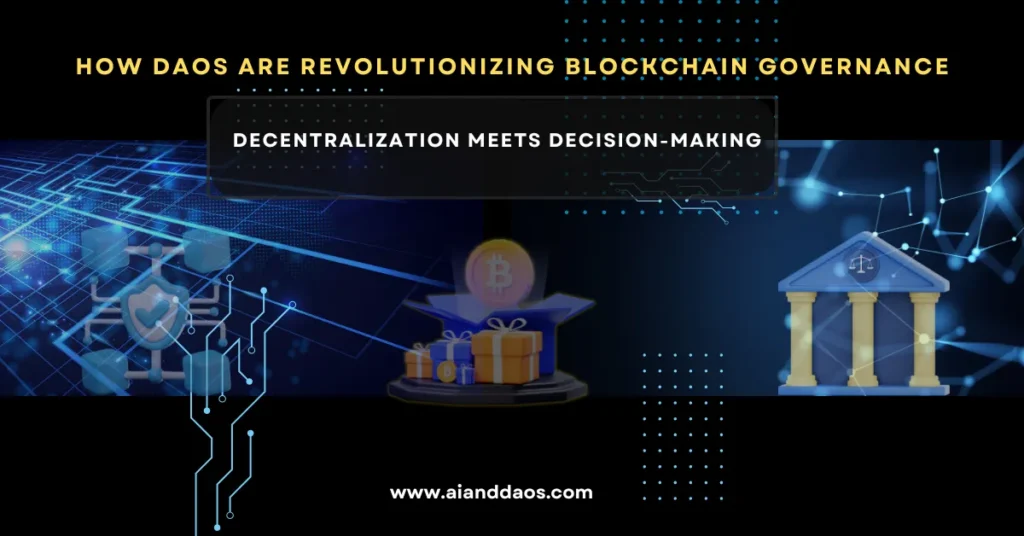
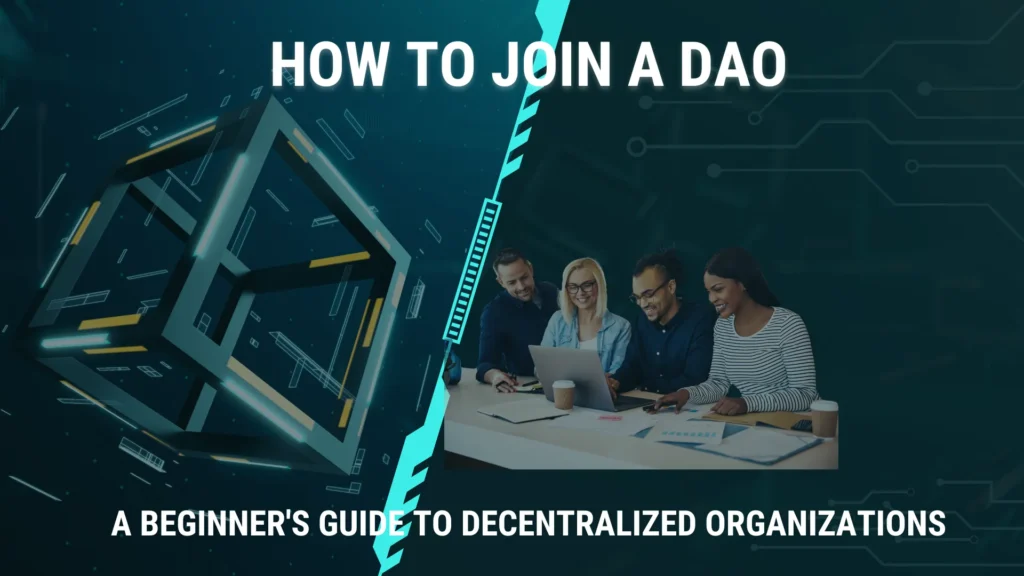
Pingback: AI in Web3 Marketing: The Future of Personalization
Pingback: AI for Content Creation: Boosting DAO Success & Efficiency
Pingback: Blockchain and AI: the Future of Decentralized Intelligence